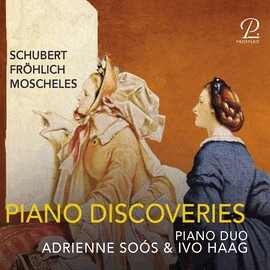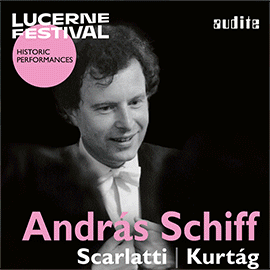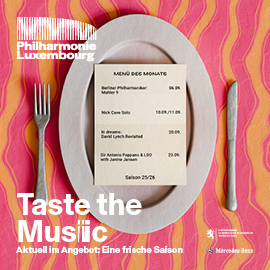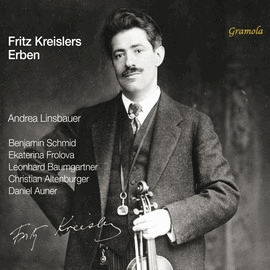 Jacques Offenbach: Les Contes d’Hoffmann; John Osborn (Hoffmann), Irene Roberts (Muse/Nicklausse), Nina Minasyan (Olympia), Christine Rice (Giulietta), Ermonela Jaho (Antonia), Erwin Schrott (Lindorf, Coppélius, Miracle, Dapertutto), Chorus of the Dutch National Opera, Rotterdam Philharmonic Orchestra, Carlo Rizzi; 1 Blu-ray C-Major 752904; Bild 16:9; Stereo & Surround; Liveaufnahme 2019, Veröffentlichung 03/2020 (165') - Rezension von Remy Franck
Jacques Offenbach: Les Contes d’Hoffmann; John Osborn (Hoffmann), Irene Roberts (Muse/Nicklausse), Nina Minasyan (Olympia), Christine Rice (Giulietta), Ermonela Jaho (Antonia), Erwin Schrott (Lindorf, Coppélius, Miracle, Dapertutto), Chorus of the Dutch National Opera, Rotterdam Philharmonic Orchestra, Carlo Rizzi; 1 Blu-ray C-Major 752904; Bild 16:9; Stereo & Surround; Liveaufnahme 2019, Veröffentlichung 03/2020 (165') - Rezension von Remy Franck
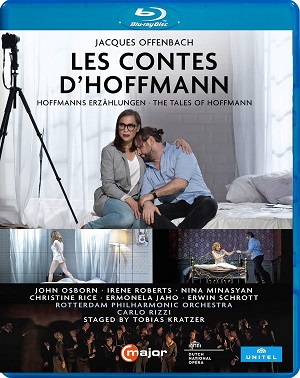
Man nehme ein Haus mit drei Wohnebenen und schneide die Fassade heraus, so dass man von außen in die einzelnen Wohneinheiten sehen kann. In diesem Haus spielt sich die von Rainer Sellmaier ausgestattete und von Tobias Kratzer inszenierte Offenbach-Oper Les Contes d’Hoffmann. In der ersten Etage befindet sich Hoffmanns Wohnung, in der er sich mit seinen Freunden (und mit der Muse) trifft, säuft und kokst. Drum herum befinden sich die übrigen Räume, die für die Geschichte benötigt werden. Für den vierten Akt öffnet sich sogar ein Kellergewölbe mit direktem Zugang zu den Egoûts, und aus der Kanalisation kommen die skurrilsten Figuren, Ganoven, Nutten und Drogenabhängige. Das Ganze ist brillant, funktioniert perfekt flüssig und hat, das Wortspiel sei erlaubt, nicht einigen einzigen Kratzer. Das liegt aber nicht nur am Set, sondern auch an der Personenführung. Kratzer führt seine Sänger wie ein genialer Puppenspieler. Was er schauspielerisch aus den Figuren herausnimmt, ist stupend. Freilich machen es ihm John Osborn als Hoffmann und vor allem Erwin Schrott in der Viererrolle Lindorf, Coppélius, Miracle und Dapertutto leicht. Sie sind nicht nur gute Sänger, sondern auch tolle Schauspieler. Dabei gelingt es Schrott nicht nur, die vier Typen stimmlich, sondern auch schauspielerisch wunderbar zu differenzieren.
John Osborn gilt zurzeit als einer der besten Hoffmann-Interpreten, und er wird diesem Ruf in dieser Produktion vollauf gerecht. Die drei Frauen in die sich Hoffmann verliebt, Nina Minasyan (Olympia), Ermonela Jaho (Antonia) und Christine Rice (Giulietta) sind alle drei hervorragend gut. Exzellent ist auch Irene Roberts als Muse. In den Dienerrollen Andrès, Cochenille, Frantz und Pitichinaccio ist der südafrikanische Tenor Sunnyboy Dladla ein weiteres gutes Element der Besetzung, deren Nebenrollen allesamt zufrieden stellen.
Am Pult des Rotterdamer Philharmonischen Orchesters dirigiert Carlo Rizzi mit viel Elan, und es gelingt ein flüssiges Dirigat, das auch Chor, Solisten und Orchester recht gut ausbalanciert.
Take a three-story house and cut out the façade so that you can see into the individual residential units from the outside. Such a house is the setting for the Offenbach opera Les Contes d’Hoffmann, directed by Tobias Kratzer and designed by Rainer Sellmaier. On the first floor is Hoffmann’s apartment, where he meets his friends (and the muse), drinks and does coke. Around it are the other rooms needed for the opera. For the fourth act even a cellar vault opens up with direct access to the sewer system, from where arrive the most bizarre characters, crooks, whores and drug addicts. The whole staging is brilliant and works perfectly well. Kratzer is directing his singers like a brilliant puppeteer. Of course, John Osborn as Hoffmann and especially Erwin Schrott in the four-part role of Lindorf, Coppélius, Miracle and Dapertutto make it easy for him. They are not only good singers, but also great actors. Schrott succeeds in perfectly differentiating the four characters vocally as well as in terms of acting.
John Osborn is currently considered one of the best Hoffmann interpreters, and he fully lives up to this reputation in this production. The three women Hoffmann falls in love with, Nina Minasyan (Olympia), Ermonela Jaho (Antonia) and Christine Rice (Giulietta) are all three outstandingly good. Irene Roberts is an absolutely great muse. In the servant roles of Andrès, Cochenille, Frantz and Pitichinaccio the South African tenor Sunnyboy Dladla is another good element of the cast. All other roles are well cast too.
Carlo Rizzi’s conducting at the helm of the Rotterdam Philharmonic Orchestra is highly efficient and also balances the choir, soloists and orchestra quite well.








